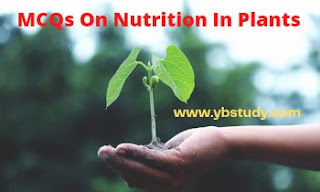MCQ Questions for Class 7 Science Chapter 1
MCQs Questions For Class 7 Science Chapter 1
All living organisms require energy for their life processes. Plants prepare their food and acquire nutrients from abiotic components like soil, air, water and sunlight. On the other hand, animals need to get food from either plants or other animals to obtain nutrients. animals need to take food to acquire nutrients and energy. In the presence of sun, green plants prepare their own food using chlorophyll, carbon dioxide, and water absorbed from the environment is called Photosynthesis. For food synthesis, plants use simple chemical ingredients such as carbon dioxide, water, and minerals.
Class 7 Science Chapter 1 MCQs
1) The food making process in plants is called as________________
(a) glycolysis
(b) photosynthesis
(c) photolysis
(d) chemosynthesis
Answer: (b)
2) What is the ultimate source of energy for all living organisms?
(a) Water energy
(b) Wind energy
(c) Solar energy
(d) Chemical energy
Answer: (c)
3. Green pigment present in the leaves is called_______________
(a) haemoglobin
(b) globulin
(c) albumin
(d) chlorophyll
Answer: (d)
4. The raw materials for photosynthesis are_____________
(а) CO2
(b) CO2, O2, H2
(c) N2 water
(d) O2 water
Answer: (а)
5. Which one of the following is a parasite?
(a) Lichen
(b) Cuscuta
(c) Pitcher plant
(d) Rhizobium
Answer: (b)
6. Which one of the following is a pair of symbiotic organisms?
(a) Lichens
(b) Rhizobium and a legume
(c) Both (a) and (b)
(d) None of the above
Answer: (c)
7. Human beings can be categorised as___________
(a) parasite
(b) heterotrophs
(c) saprotrophs
(d) autotrophs
Answer: (b)
8. Which of the following is an insectivorous plant?
(a) Pitcher plant
(b) Cuscuta
(c) Algae
(d) Lichens
Answer: (a)
9. The organisms which prepare their own food are known as_______________
(a) saprotrophs
(b) autotrophs
(c) heterotrophs
(d) none of these
Answer: (b)
10. Photosynthesis will not occur in leaves in the absence of_____________
(a) guard cells
(b) chlorophyll
(c) vacuole
(d) space between cells
Answer: (b)
11. Which one of the following is an autotroph?
(a) Lichens
(b) Algae
(c) Fungus
(d) Cuscuta
Answer: (b)
12. Numerous small openings observed under the lower surface of a leaf through a magnifying lens are__________
(a) stomata
(b) lamina
(c) midrib
(d) veins
Answer: (a)
13. Plants take in carbon dioxide from the atmosphere generally through__________
(a) flowers
(b) stem
(c) root
(d) leaves
Answer: (d)
14. Guard cell in dicots are___________
(a) dumbbell-shaped
(b) biconcave
(c) biconvex
(d) bean-shaped
Answer: (d)
15. Most of the plants are___________
(a) omnivores
(b) herbivores
(c) heterotrophs
(d) autotrophs
Answer: (d)
16. Which material is not required for photosynthesis?
(a) Water
(b) Carbon dioxide
(c) Chlorophyll
(d) Oxygen
Answer: (d)
17. The substance synthesised during photosynthesis is____________
(a) protein
(b) maltose
(c) fructose
(d) glucose
Answer: (d)
18. Pitcher plant is an example of__________
(a) autotroph
(b) heterotroph
(c) saprotroph
(d) partial heterotroph
Answer: (d)
19. Chlorophyll is found in oval-shaped structures called as____________
(a) stomata
(b) stoma
(c) chloroplast
(d) centrioles
Answer: (c)
20. What is the role of the bacteria in leguminous plants?
(a) Convert oxides of nitrogen into soil nitrates.
(b) Convert atmospheric nitrogen gas into soil nitrates.
(c) Convert soil nitrates into gaseous nitrogen.
(d) Convert plant proteins into ammonia.
Answer: (b)
21. Algae and fungi live together in_________
(a) Shrubs
(b) Herbs
(c) Lichen
(d) Pinus
Answer: (c)
22. The byproduct of photosynthesis is____________
(a) Energy
(b) Water
(c) Oxygen
(d) Organic compounds
Answer: (c)
23. The bacterium which provides nitrogen to the leguminous plants is___________
(a) Lichens
(b) Fungi
(c) Yeast
(d) Rhizobium
Answer: (d)
24. Which one is saprophytic organism?
(a) Algae
(b) Mushroom
(c) Cuscuta
(d) Mango
Answer: (b)
25. In non-green plants and animals mode of nutrition is_____________
(a) Saprophytic
(b) Parasitic
(c) Heterotrophic
(d) Autotrophic
Answer: (c)
26. Which one is a total parasite?
(a) Deodar
(b) Cuscuta
(c) Amoeba
(d) Mistle-toe
Answer: (b)
27. Which of the following is a nutrient?
(a) Fats
(b) Vitamins
(c) Proteins
(d) All of these
Answer: (d)
28. Plants take carbon dioxide from the atmosphere mainly through their_______
(a) Roots
(b) Stem
(c) Flowers
(d) Leaves
Answer: (a)
29. Pitcher Plant Traps Insect Because It_____________
(a) is a heterotroph.
(b) grows in soils which lack in nitrogen.
(c) does not have chlorophyll.
(d) has a digestive system like human beings.
Answer: ( b)
30. Tiny pores present on the surface of leaves through which gaseous exchange occurs are called_______________
(a) stomata
(b) guard cells
(c) food holes
(d) gas holes
Answer: (a)

